Implementing AI Radiology Software in Veterinary Practices
Published by Karen E. Felsted, CPA, MS, DVM, CVPM, CVA on June 13, 2022
Click here to download this article as a PDF.
INTRODUCTION
Veterinarians have a clear understanding of the benefits radiology provides — the accurate and timely diagnosis of disease and injury using a safe, quick, affordable and non-invasive modality. However, these benefits are all dependent upon an accurate reading of the radiographic images and this is often harder for DVMs when compared to other diagnostic tools such as laboratory testing.
There are many studies in human medicine that document the difficulties board-certified human radiologists regularly have in reading films. These include disagreements amongst radiologists when reviewing the same film and disagreement with their own original findings when looking at a particular image a second time around. It is safe to assume that the art of reading films is even more challenging for veterinary general practitioners who have less training than either human or veterinary radiologists and must interpret findings from multiple species.
 Figure 1: Challenges in reading radiographic images
Figure 1: Challenges in reading radiographic images
Challenges in reading radiographic images include:
- Long turnaround times with outside readings
- Cost of outside interpretation which may influence a client’s decision to select this service
- Increased demand for outside reading of images by board-certified radiologists resulting in long delays for interpretations and consultations
- Lack of training/experience and limited ability to consult with colleagues
- Innate subjectivity in making interpretations
- Tunnel vision/focus on “expected” findings
- Diagnostic confidence
Fortunately, the rising availability and use of AI (artificial intelligence) options in veterinary radiology can be very helpful to a practice in addressing some of these concerns. AI shouldn’t be thought of as a replacement for the skills and knowledge of any veterinarian, general practitioner, or specialist (particularly a board-certified radiologist.) AI is an ancillary tool designed to help improve patient care, the client experience, and veterinary practice efficiency. According to Dr. Doug McInnis with East and West Ridge Animal Hospitals in Klamath Falls, OR, “We find SignalPET to be a very helpful tool in interpreting radiographs. In my opinion, the biggest benefit is the additional knowledge we gain which results in better diagnosis and better treatment recommendations. As general practitioners, the use of AI in radiology adds to our knowledge and experience in reading radiographs and at our practice, we send more radiographic studies out for interpretation by board-certified radiologists than we did previously because of the more detailed interpretations we have as a starting point."
DESCRIPTION OF TECHNOLOGY
There are several radiology AI options available in veterinary medicine; the following is a description of that developed by SignalPET.
SignalPET is a patented software platform that uses artificial intelligence (AI) and machine learning to quickly and accurately “read” radiographs. A team of highly skilled veterinarians including general practitioners, board-certified radiologists, and other specialists, created and then used the largest database of annotated veterinary radiographs (over 2M images) in the world to develop the technology. Utilizing these images, AI has been trained to successfully recognize greater than 50 signs on radiographic films (including thoracic, abdominal, spine, pelvis, forelimb, hind limb, and dental) in animals of varying sizes and weights signaling the presence or absence of specific pathologies. The company continues to make advancements in a field in which protocols and guidance did not previously exist.
The process by which studies are interpreted by these AI algorithms were designed to seamlessly incorporate into a hospital’s pre-existing workflow, using the x-ray equipment and Practice Information Management System (PIMS) already present in veterinary clinics. No additional equipment is required. Radiographs are taken by the technician as would be normally done and then uploaded to a web-based PACS system; this upload can be done automatically with most PIMS. Each image is analyzed by AI technology, and within minutes a report for the study is generated. Clinic staff members are able to then view the images and the report on any web browser on any computer with internet access. Because results are returned within minutes, it is possible for the practice team and the client to make important diagnostic and treatment decisions before the pet is sent home. The process was designed to assist the clinician with diagnostics in a prompt and efficient manner and developed with clinic work processes in mind.
A strict quality control process has been implemented in order to monitor, maintain, and refine the ongoing quality of interpretations. The process allows for the SignalPET medical team to audit a significant portion of images and use feedback to continually improve AI performance. This ensures consistent and reliable results at a 95% accuracy rate.
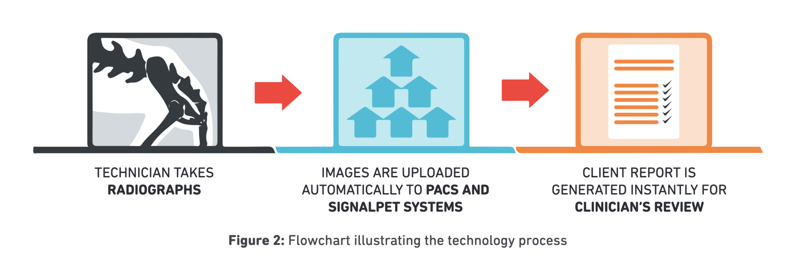
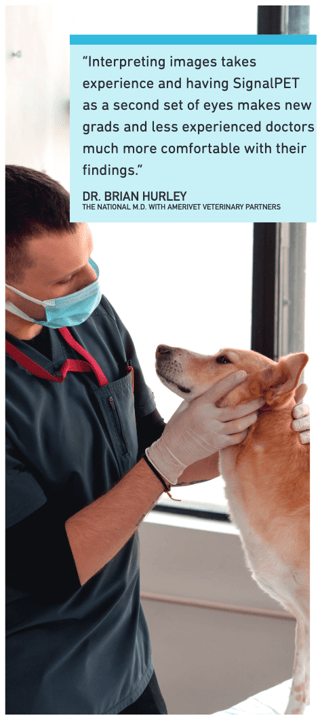
The benefits to pets, pet owners, and the veterinary practice from adding and utilizing a high-quality diagnostic tool may seem obvious but are worth discussing in some detail. The most important factor practices take into consideration in almost every medical and management decision they make is: How will this impact the quality of care the practice provides?
The use of an AI radiology tool essentially puts another set of “eyes” on the image and either confirms the original findings of the practice team or may identify some additional findings as well. Either will improve the confidence the team has in the reading and offers stronger support for the diagnosis and pet owner recommendations. This is particularly helpful for recent graduates or those with less radiograph interpretation experience. Dr. Brian Hurley, the National Medical Director with AmeriVet Veterinary Partners had this to say: “One of the biggest benefits for our practices from using SignalPET is with new graduates or those doctors with less confidence in reading radiographs. Interpreting images takes experience and having SignalPET as a second set of eyes makes them much more comfortable with their findings and is a good learning tool as well. In addition, it takes the burden of reviewing each of their radiographs off the more experienced veterinarians and when practices are as busy as they are now, this really helps!”
Pet owners expect high-quality medicine from the practice they have chosen to take their pets to and they like the idea that their pet’s radiographs are reviewed by a second party. If the primary care practitioner feels the films should still be read by a board-certified radiologist, the AI findings often offer support for this, and pet owners may be more willing to accept this recommendation and the cost that goes with it. Not only does the AI reading offer valuable information to the practice team, but the process is also very quick.
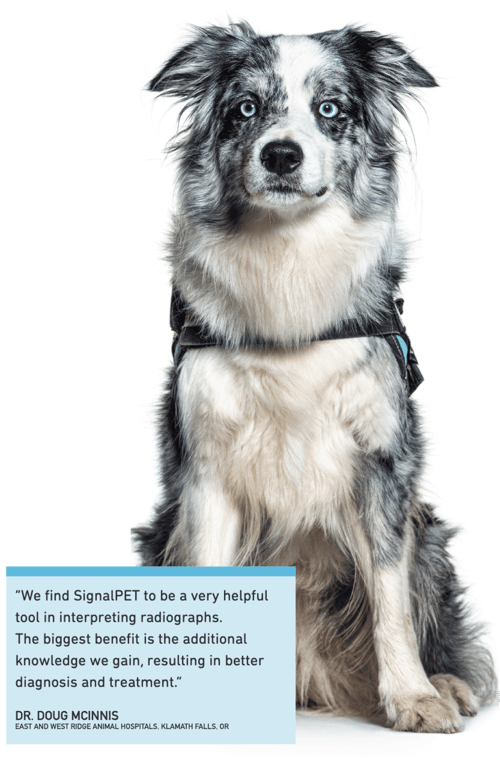
Most reports are turned around within three minutes, 24/7/365. Not only are pet owners busy and appreciate getting the information they need as quickly as possible, but time can be a significant issue in making appropriate treatment decisions in more critical cases. Depending on the practice’s chosen workflow, this turnaround time can also eliminate the need for the practice team to later have to call the pet owner back with the findings and update the discussion about the pet’s condition. Most practices provide print or electronic versions of the AI reports to their clients. These reports contain both the images taken by the practice, as well as information on the AI findings. This additional form of communication emphasizes the importance and value of having this diagnostic test done.
The cost of the AI reading is modest and when passed on to the client, generally with a markup, not only improves the quality of care and the client experience but increases revenue and profits in the practice as well. Dr. McInnis noted the following “The physical reports generated by SignalPET have been well received by our clients and add value to the entire radiology experience. And because the reports are returned very quickly, most of our clients have further recommendations for other diagnostics and treatment recommendations before they leave the practice. We increased our standard radiology fees to include the SignalPET interpretation and because we are including this in most radiographic studies, we’ve seen an increase in revenue for these types of appointments. Better diagnostic interpretations can also lead to more comprehensive treatment recommendations which can drive increased revenue as well. The team members at our practice work in veterinary medicine because they want to see pets get the best care possible and any tool or resource that improves this quality of care also helps with our employee/team retention.”
FINANCIAL IMPACT
While practices don’t generally offer a new service to clients simply to increase revenue and profits, there’s no question that a new service or product offering that increases the quality of care provided can also have a positive financial benefit to the practice.
Both the AAHA Financial and Productivity Pulsepoints and the Well-Managed Practice Benchmarks Study series include some imaging revenue and expense benchmarks, but beyond that, there is limited published data about the use of imaging in practices or the financial benefit derived from it. Comparing imaging metrics from period to period can be very helpful to a practice in measuring the usage and change in usage of imaging, particularly when a new service or protocol such as the use of radiology AI is introduced in the practice.
Data provided to SignalPET by one group of about 15 practices showed an overall increase in total radiology revenue, the number of radiographs taken, and the revenue per radiograph after implementing the use of this tool in their practices. Other practices have reported similar increases.
It’s also important to remember that radiology equipment costs the same whether it is used once a week or fifty times a week; anything that increases the number of images taken results in better utilization of the equipment and a reduced cost to the practice per image.
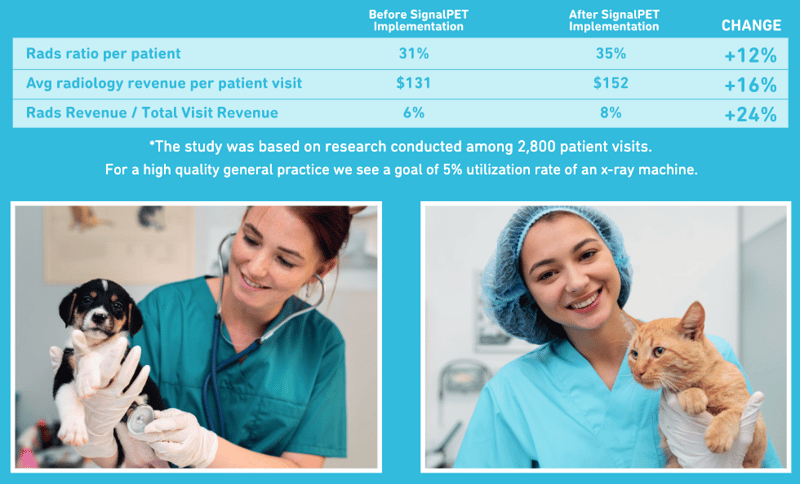
IMPLEMENTATION OF AI IN YOUR PRACTICE
Veterinary AI radiology services are provided by several different companies and each will have different features. Selecting a partner company is the first step toward implementation. Factors to consider in selecting a radiology AI provider include:
- Development, proprietariness and accuracy of the AI algorithm
- Process for ongoing revision and upgrade of AI algorithm
- Range of body areas and clinical problems assessed
- Ease of integration of AI process into practice’s existing workflow
- Need for additional practice equipment, if any
- Ease of uploading images for reading and interpretation
- Turnaround time for study reports
- Ease of retrieving and reviewing reports
- Quality of reports - usefulness to both clinicians and pet owners
- AI provider support–type, hours
- Cost
Once a provider has been selected, the technology must be set up in the practice, workflow integration decided upon and the practice team trained. Implementation will vary depending on the provider selected. With the SignalPET service discussed above, it is very simple, taking less than an hour of time and integrating seamlessly with most x-ray machines and Practice Information Management System setups.
Different practices will integrate the technology differently in their practices based on their processes and workflow. There is usually little to no change in the process of actually taking the radiographs. In many cases, the radiographs can be automatically uploaded to the AI provider site; if this isn’t possible; then it needs to be determined who will do that and at what point in the process. The biggest difference across practices is in how and when doctors get the AI report and discuss those findings with their clients. For example, in some practices, the doctor gets the report within minutes of taking the x-rays and discusses it with the client before they leave the building. In other practices, the doctor has an initial conversation with the client based on their own reading of the images, reviews the AI report later in the day, and then discusses any updates to their findings with the clients. Some practices specifically discuss the use of the AI service with their clients; others don’t. The AI report becomes part of the pet’s medical record, either in paper version or electronically. The flexibility in usage is attractive to practices with different ways of doing things.
No matter how a practice chooses to implement the technology, they must make sure everyone is clear on their individual roles and responsibilities in utilizing this new technology. Examples include:
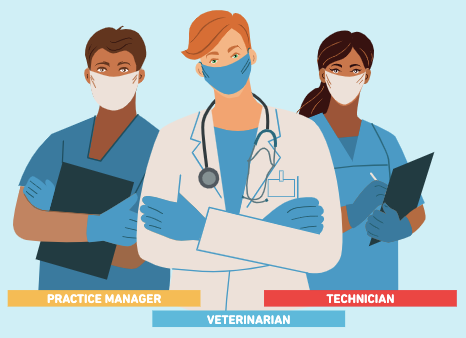
Doctors — use the results from the AI provider, along with their own findings from reading the images, to determine a diagnosis and treatment plan for pets, appropriately incorporate AI findings into the medical record, communicate with clients about their findings
Practice managers — update radiographic service descriptions and prices in the PIMS, organize team training, develop marketing information for pet owners
Technicians and veterinary assistants — take images, upload images to the AI platform if can’t be done automatically, retrieve reports and give to doctor
All employees — understand the value of the service, the benefits to pets and pet owners and how to talk about it to clients where appropriate in the practice’s workflow
Most practices include the use of the AI service with all radiographs. A fee for the service is either charged separately for the service or simply incorporated into the total cost of the radiographs. Most practices markup the cost from the AI provider which results in additional profit for the practice. The integration of AI radiology into the practice is a good time for the practice to review and/or create its own radiology recommendation standards. Radiology protocols usually cover the situations in which the medical team thinks radiographs should be recommended and the types of films that should be taken. Any kind of medical protocol isn’t meant to be a mandate that doctors must follow each and every time. They are meant to be a written guideline stating what the practice thinks is the best medicine in various situations, with the understanding that if a client declines the recommendation or a doctor doesn’t think it is warranted in a particular case, the protocol doesn’t have to be followed. Not only does the process of creating protocols allow doctors to talk through how they think cases should be best handled but the finished product can also serve as a training tool for all team members.
Team training is clearly important with the implementation of AI in the practice. Because the set-up and usage process is easy, this doesn’t have to take long. However, it is important for all team members to have some understanding of how AI technology works in veterinary radiology, why it is useful in the practice, and, most importantly, why it benefits pets and pet
owners as well as specifically how the AI information will be used in their practice. Team members should also understand how the service will be priced and how to communicate the benefits of the service to pet owners. As with any training, make it as interesting and interactive as possible for the best results and to get full team participation. Not everyone learns best via lecture so incorporate different communication methods and interactive activities to cover the gamut of learning styles amongst your team. Ask a team member to volunteer their pet (at no charge to them of course!) for a series of radiographs after which the AI report can be reviewed. Ask your AI provider if they offer brochures, posters, or other information to help with educating both team members and pet owners about the reading of images and the added value of using AI. As with any new service, the practice’s management team should track appropriate metrics and measure the success of the program by comparing key metrics from before the implementation of the AI program to after implementation. Key metrics include:
- Radiology revenue as a % of total gross revenue
- Number/% of pets seen who have x-rays done
- # of studies—total, per patient
- # of images—total, average per study
- Email open rate, if AI reports are sent electronically to the client
- Client satisfaction
- Doctor satisfaction with the use of AI in general and the particular provider chosen as well
Another important metric, although not directly related to the use of an AI provider, is the number and percentage of clients who accept an x-ray recommendation as a percentage of all clients for whom this recommendation is made. If very few clients are accepting x-ray recommendations, the practice should review pricing and how the benefits of having the pet x-rayed are communicated to the client.
SUMMARY
The rising availability and use of AI (artificial intelligence) options in veterinary radiology can be very helpful to practices in addressing some of the challenges veterinarians currently face in reading and communicating the benefits and results of radiographs. Fortunately, implementing an AI component into the practice’s workflow doesn’t have to be difficult, costly, or time-consuming, and all parties benefit from utilizing this advanced technology—the pet, the pet owner, the veterinary team, and the practice.
COMPANY OVERVIEW
SignalPET focuses on improving pet healthcare by providing rapid clinical results through standardized radiograph interpretation. SignalPET's software utilizes artificial intelligence and machine learning technology to analyze radiographs using existing radiography equipment. The solution has proven to help reduce radiograph interpretation errors, increase machine utilization, reduce the number of outside radiology consults, and help expedite treatment plans for companion animals. SignalPET is a US-based company with a worldwide presence and over 100 employees. The technology has been used by 1,000+ hospitals and over 10,000 clinicians, including hospitals of most of the large, corporate-owned veterinary hospital groups in the US. Over 2,000,000 films are reviewed annually.
AUTHOR

Karen E. Felsted, CPA, MS, DVM, CVPM, CVA
PantheraT Veterinary Management Consulting
Dr. Felsted is a CPA as well as a veterinarian and has spent the last 20 years working as a financial and operational consultant to veterinary practices and the animal health industry. She is active in multiple veterinary organizations, has written an extensive number of articles for a wide range of veterinary publications and speaks regularly at national and international veterinary meetings. In 2011 and 2017, she was awarded the Western Veterinary Conference Practice Management Continuing Educator of the Year and in 2014, the VetPartners Distinguished Life Member Award.